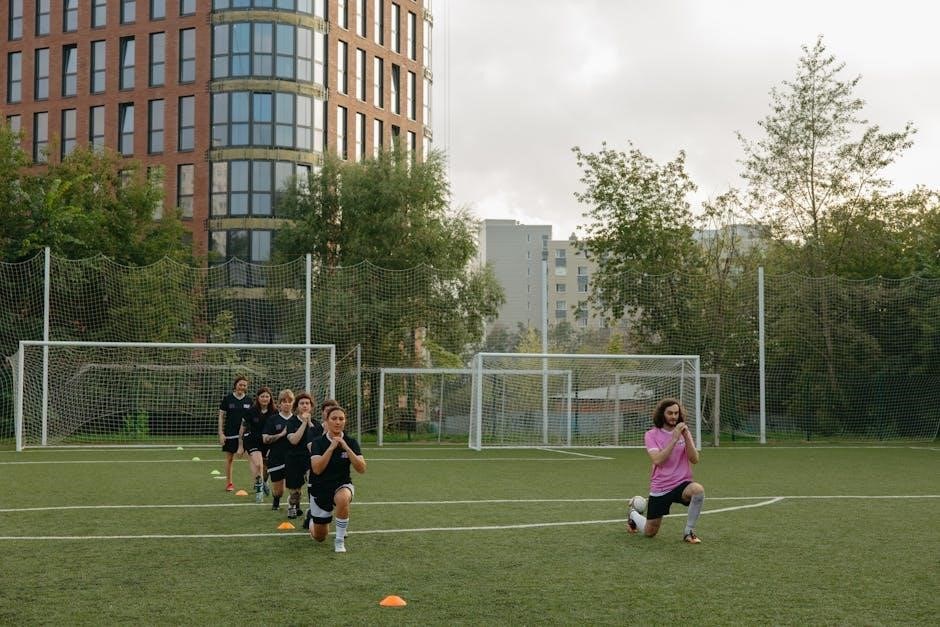Warm-Up Drills
This section outlines essential warm-up exercises to prepare players physically and mentally. Dynamic stretching, footwork drills, and coordination exercises are emphasized to improve agility, balance, and focus.
1.1 Dynamic Stretching Exercises
Dynamic stretching exercises are crucial for preparing players’ muscles for physical activity. These exercises involve controlled movements that mimic soccer actions, such as high knees, leg swings, and lunges. Players perform exercises like zig-zag runs, shuttle runs, and toe taps to improve flexibility and coordination. Dynamic stretching enhances blood flow, reduces muscle stiffness, and lowers the risk of injury. Examples include arm circles, hip opens, and calf raises. These drills are typically done in a sequence, gradually increasing intensity to prepare the body for more demanding movements. Incorporating dynamic stretching into warm-ups ensures players are physically and mentally ready for training or competition, setting the foundation for effective performance.
1.2 Ball Control Warm-Up Routines
Ball control warm-up routines are designed to improve a player’s ability to manipulate the ball effectively. These drills focus on dribbling, footwork, and coordination. Players perform exercises like figure-eights around cones, weaving through ladders, and controlling the ball in tight spaces. Drills such as “Breathing Room” and “Fox & The Hounds” emphasize quick touches and precise movements. These routines help players develop their first touch, balance, and confidence with the ball. By incorporating small group activities and individual challenges, coaches ensure players are engaged and prepared for more complex skills. Ball control warm-ups are essential for building the foundation of technical proficiency in soccer.
Technical Drills
Technical drills focus on improving fundamental soccer skills like passing, shooting, and ball control. These exercises enhance precision, power, and consistency in executing key techniques during matches.
2.1 Passing Accuracy Drills
Passing accuracy drills are designed to refine players’ ability to deliver precise passes under various conditions. One effective drill involves players standing in pairs, focusing on short, firm passes using the inside of the foot. Gradually increase the distance between pairs to challenge accuracy. Another drill places players in a square formation, requiring them to pass the ball to a teammate while moving. These exercises emphasize proper technique, weight distribution, and vision, ensuring players can consistently deliver accurate passes during gameplay, which is crucial for maintaining possession and creating scoring opportunities.
2.2 Shooting Technique Drills
Shooting technique drills focus on developing precision, power, and confidence in front of goal. Players practice shooting with both feet, emphasizing proper ball striking and follow-through. A common drill involves shooting from varying distances, requiring players to adjust their technique for accuracy. Another exercise includes shooting on the move, simulating game-like scenarios. Goalkeepers are often incorporated to add pressure, while defenders may apply light pressure to simulate match conditions. These drills also include variations, such as volleys and half-volleys, to refine technique. Regular practice helps players develop a consistent shooting form and the ability to score in high-pressure situations, making them more effective in competitive play.
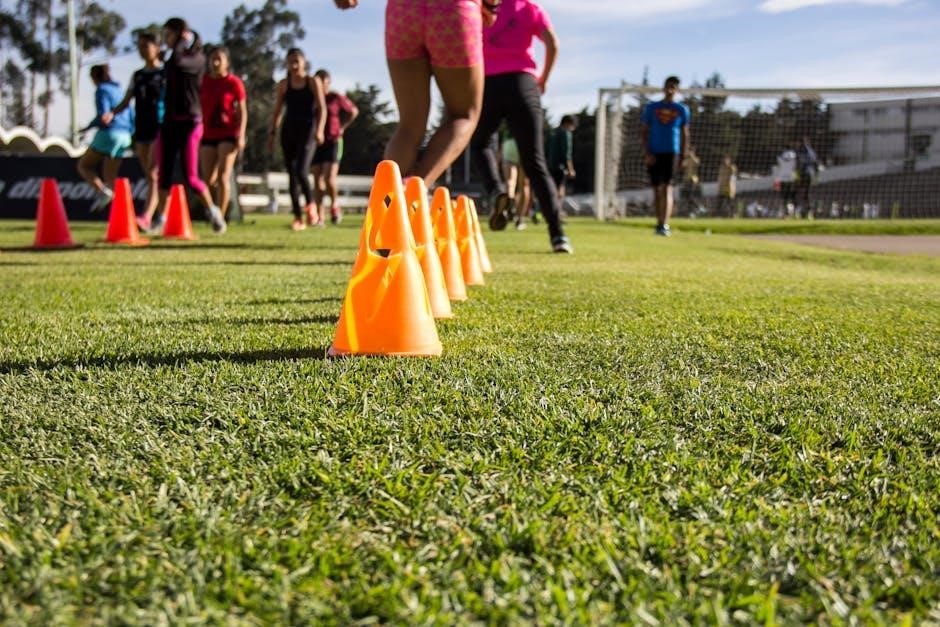
Tactical Drills
Tactical drills enhance teamwork, decision-making, and game awareness. They include small-sided games, positional exercises, and scenario-based training to simulate real match situations and improve strategic play.
3.1 Attacking Strategies
Attacking strategies focus on creating scoring opportunities through teamwork and precision. Drills like the “Wall Bounce Pass Solo Soccer Drill” enhance passing accuracy and control, while “Fox and The Hounds” improves teamwork and sharp passing skills. These exercises simulate game scenarios, encouraging players to think critically and act swiftly. Coaches emphasize the importance of creativity, decision-making, and exploiting defensive weaknesses. Players learn to position themselves effectively, use space wisely, and coordinate attacks seamlessly. These drills build confidence and ensure players are prepared to execute strategies during actual matches, fostering a cohesive and formidable attacking unit.
3;2 Defending Strategies
Defending strategies are crucial for maintaining team stability and preventing opponents from scoring. Drills such as “Attacking vs. Defending in a Grid” and “Defensive Line Coordination” focus on improving reaction time, positioning, and communication. Players learn to anticipate opponents’ moves, protect the ball, and maintain defensive shape. These exercises emphasize the importance of teamwork, with drills encouraging defenders to work in units and respond effectively to various attacking scenarios. By practicing these strategies, players develop the skills to read the game, intercept passes, and regain possession efficiently. Coaches highlight the value of discipline and composure under pressure, ensuring defenders are well-prepared to counter any offensive tactics.
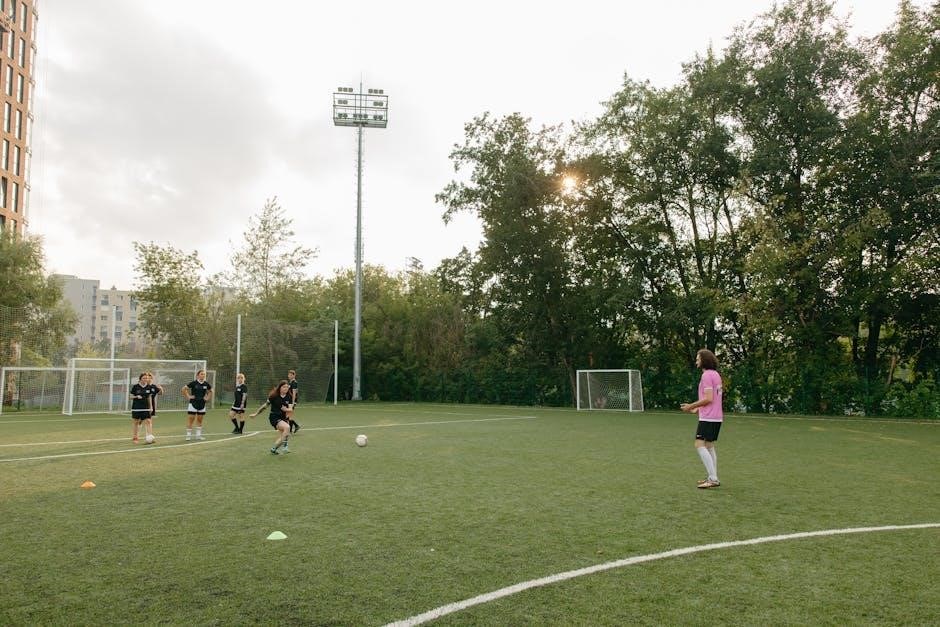
Fitness and Conditioning Drills
Agility ladder drills improve speed and coordination, while endurance exercises enhance stamina. Cone drills focus on quick direction changes, ensuring players are physically prepared for match demands.
4.1 Agility Ladder Drills
Agility ladder drills are essential for enhancing speed, coordination, and reaction time. These exercises involve navigating through a ladder using various footwork patterns. Start with basic drills like the “Ickey Shuffle” or “Carioca Drill,” where players weave through the ladder using quick lateral movements. Progress to more complex patterns, such as high knees or alternating feet, to challenge balance and agility. Incorporate reaction training by adding verbal cues or signals for direction changes. Agility ladder drills are versatile and can be tailored to different skill levels, making them a valuable tool for improving overall fitness and soccer performance. They are also time-efficient and require minimal equipment, making them ideal for both individual and team training sessions.
4.2 Endurance Building Exercises
Endurance building exercises are crucial for soccer players to maintain stamina throughout the game. These drills focus on improving cardiovascular fitness and increasing lung capacity. Start with interval training, such as sprinting for 30 seconds followed by 30 seconds of rest, repeating for 15-20 minutes. Incorporate long-distance runs at a moderate pace to build stamina. Shuttle runs, where players run back and forth between two points, are also effective. Additionally, high-intensity interval training (HIIT) with burpees, jump squats, and mountain climbers can enhance both endurance and strength. These exercises help players sustain energy levels during matches and recover quickly between plays, ensuring peak performance from start to finish.
Small-Sided Games
Small-sided games like 3v3 and 4v4 scrimmages are ideal for improving teamwork, strategy, and decision-making in tight spaces, enhancing overall soccer performance and player engagement effectively.
5.1 3v3 Scrimmage Drills
3v3 scrimmages are excellent for improving close control, teamwork, and decision-making in tight spaces. Players are divided into small teams, fostering creativity and quick thinking. These drills enhance ball retention, vision, and spatial awareness while encouraging attacking and defending strategies. The reduced field size accelerates the game pace, simulating real match scenarios. Coaches can introduce variations, such as no offside rules or time limits, to focus on specific skills like passing accuracy or shooting technique. This format allows for high-intensity, engaging practice, ensuring active participation and skill development across all players, making it ideal for both youth and advanced training sessions to refine tactical awareness and physical fitness simultaneously.
5.2 4v4 Game Situations
4v4 game situations are ideal for simulating real match conditions while maintaining a focus on skill development. These drills encourage quick decision-making, creativity, and teamwork in a dynamic environment. Players benefit from increased ball contact and the opportunity to practice both attacking and defending strategies. The smaller field size intensifies the action, promoting agility, spatial awareness, and rapid transitions between offense and defense. Coaches can tailor the drills to emphasize specific skills, such as passing accuracy, dribbling, or shooting technique. This format also allows for the introduction of tactical elements, like overlapping runs or pressing strategies, making it versatile for various age groups and skill levels. It’s an effective way to bridge technical practice with game-like scenarios, ensuring players are prepared for competitive play.
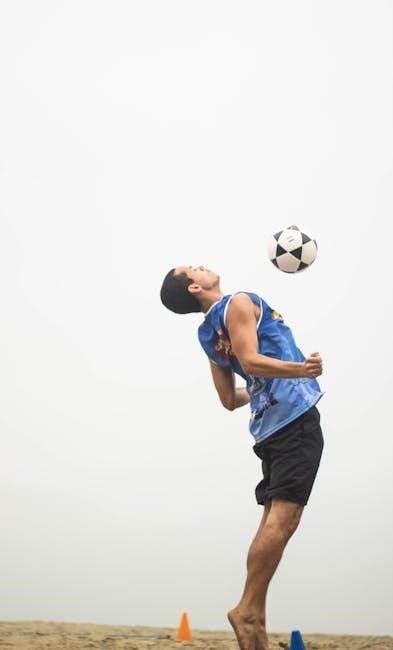
Goalkeeping Drills
Goalkeeping drills focus on improving handling, footwork, and distribution techniques. They also enhance agility, coordination, and reaction time through game-like scenarios and specialized exercises.
6.1 Handling and Footwork
Goalkeeping drills focusing on handling and footwork are crucial for developing reflexes, agility, and ball control. These exercises include catching high balls, diving saves, and footwork ladders.
Players practice handling crosses, one-on-one shots, and distribution techniques. Footwork drills involve cone mazes and shuttle runs to enhance speed and coordination.
These drills simulate game scenarios, improving reaction time and decision-making under pressure.
Coaches often incorporate wall ball exercises for precise volleys and passes.
Regular practice of these drills ensures goalkeepers are confident and prepared for match situations.
6.2 Distribution Techniques
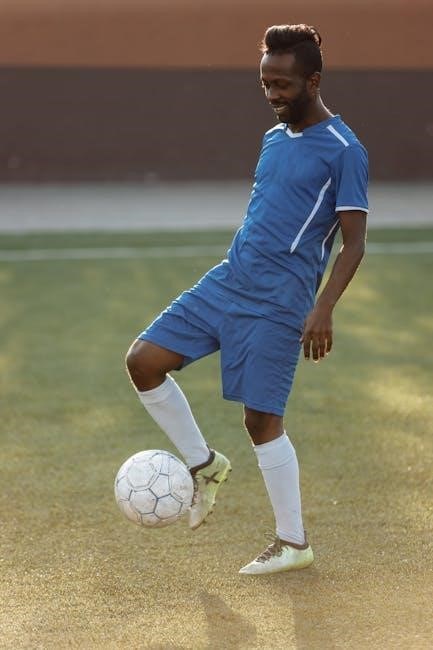
Effective distribution techniques are vital for goalkeepers to initiate attacks and maintain possession. Drills focus on accuracy and variety in passing, including short and long distribution.
Players practice using both feet, ensuring versatility in delivering the ball to teammates. Exercises involve passing to stationary and moving targets, simulating game scenarios.
Goalkeepers also work on throwing techniques, such as throw-outs and punts, to quickly transition the ball upfield. These drills aim to improve decision-making and precision under pressure.
Coaches often incorporate small-sided games to test distribution accuracy and adaptability in dynamic situations.
This comprehensive guide to soccer drills offers a wide range of exercises to enhance technical, tactical, and physical abilities. From warm-up routines to advanced distribution techniques, the drills cater to players of all skill levels.
Coaches and players alike can benefit from the structured practices, ensuring continuous improvement and teamwork.
The downloadable PDF resources provide convenience and accessibility, making it easier to plan and execute effective training sessions.
By incorporating these drills into regular practice, teams can build a strong foundation, foster creativity, and achieve peak performance on the field.

